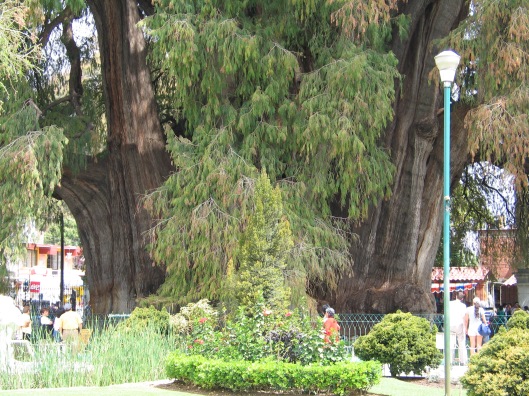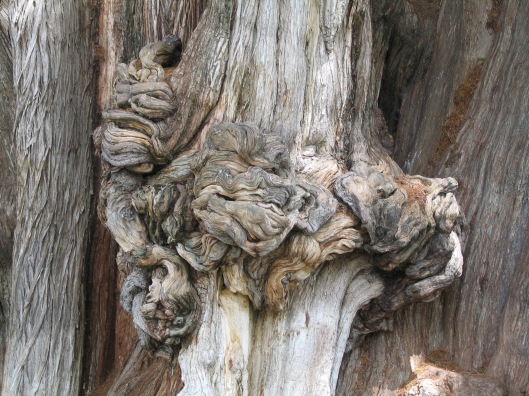The Arbole de Tule is the big one by which all baldcypress are measured. It is perhaps the largest tree in the world, depending on how you measure craggy patriarchs. A short bus ride from Oaxaca, Mexico, the tree is located in the small peaceful village of Sta. Maria del Tule with a life built around the tree and the church it shades. El Arbol rises to 140’, and looms over the bell tower of the church of Our Lady built by the Spanish over 400 years ago. Ahuehuete is a Nahuatl phrase that means “old man of the water”. “Ahuehuete O Sabino” boasts an astounding 190 feet in circumference. Some report it as much more, but remember, the trunk is quite ridged and convoluted. It is reported that it takes seventy eight children holding hands to encircle the tree. The maximum diameter is reported as 46’, and the wood in this tree is estimated at over 630 tons! As for age, the tree remains an enigma. DNA analysis has proven that this is one tree and not a comingling of many trees grown together. Most age estimates fall between 1200 and 3000 years, and the best scientific estimate based on growth rates is between 1400 and 1600 years. Local Zapotec lore has the tree planted about 1400 years ago by Pecocha, a priest of Ehecatl, the Aztec wind god, which is certainly in agreement with the scientific estimate.

My first impression of this magnificent tree was March 13, 2005, a red letter day during my honeymoon. Touching the biggest, baddest and oldest “Ahuehuete” has long been on my bucket list. There are other common names for this ancient genus including ciprés, pénjamu, sabino, Montezuma cypress and Mexican cypress. As a student of this species, I have long admired its back-to-the-dinosaurs heritage. When you touch a bald cypress, you’re touching 60 plus million years of evolution. Janet and I had made our vows in December 31, 2014, but we couldn’t break away for a honeymoon until a few months later.
I have always loved Mexico with its majestic mountains, plains, farms, cities, towns, and villages. The vistas, special botany and the people are singular and I speak enough Spanish to feel comfortable. I had persuaded Janet that Oaxaca was a great spot to light for a romantic honeymoon. It was small enough to get around by walking and it was away from the noisy touristy coastal beach vacation spots. It was low cost. There was a great center of the city, a shady plaza with evening music and great food. Of course, there were the special dishes and unique mole of this region’s cuisine. We could drink sotol or tequila with abandon and dance like there was no tomorrow. Of course, in the back of my mind I was thinking, hey, I can also get to see this tree. At dinner that evening, after visiting the tiny town of Sta. Maria del Tule and basking in the glory of the Arbole de Tule, Janet quietly remarked that I had taken over 100 images of the tree, but only two of her. I replied that I might never see the tree again, that I would see her for the rest of my life, right? This was her smile.

Seriously, this is one great tree and any search of the web will reveal a plethora of images. There are youtubes and testimonials for days. If you’re not into trees, this place may not get your heart to revving. One reviewer wrote: “No need to avoid this attraction on the way to Mitla, also no need to seek it out. Huge trunk, a very old tree. Bit boring.”



There are other ancient Taxodiums in Mexico. The remnant population in a park near Texcoco are worth a visit. While youngsters of only 500 plus years, they are still impressive and date back to the time of Cortez before Lake Texcoco was drained. Lake Texcoco was a natural lake within the valley of Mexico and is recognized as the spot where the Aztecs built the city of Tenochtitlan on an island in the lake. After the Spaniards took over, the lake was drained to control flooding and reduce mosquitoes, which led to the modern day sprawl of Mexico City. While beat up and scraggly, the trees point to a time when the tree was revered and planted in grand allees by the Aztecs.

There’s one tree left in the city of Texcoco worth visiting. Saved by Dr. Daniel Rivas Torres, a Forestry Engineer, the tree hangs precariously to life in a busy and noisy median and is thought to be over 600 years old. In 2011 the tree was given special status and is revered as the tree of Texcoco.

‘OAXACA CHILD’ – In 2013, as part of a team of Chinese, American and Mexican team of scientists, we were able to secure several small seedlings of the Arbole de Tule tree. The organizer of this trip, Dr. Teobaldo Equiluz Piedra is the owner of GenFor, a nursery that specializes in Montezuma cypress and other trees as well. The image below is at the nursery near the tree and it is this tree we have named ‘Oaxaca Child’. If you are lucky enough to get one, don’t forget you’re getting a special little piece of history.

The seedling I selected – March 2, 2013
The one gallon seedling shown above was a seedling of the largest Montezuma in the world, the grand Arbole de Tule near the mountain town of Oaxaca, thus we call it ‘Oaxaca Child’. We have offered the tree in our plant sales at SFA Gardens and have scattered it to other botanical gardens, Arboreta and private gardens. In trials in Texas, the tree has proven to be hardy, fast growing, doesn’t produce knees, quite drought resistant once established, and not prone to chlorosis in the high pH soils of central Texas. Because this is a seedling of the big one, it’s juvenile, which means it can be rooted rather easily – and that’s what we’ve done. We find the clone very easy to root (eight weeks). The image below is of a young ‘Oaxaca Child’ planted by Laurence Truett in Cypress, Texas. Laurence reports that the tree is the most evergreen of any of the Taxodium we have given him for trialing.


Kimberly Mighell with a two year old ‘Oaxaca Child’ on the campus of Tulane University, New Orleans, LA – 12-26-2016

Dr. Mengmeng Gu with a ‘Oaxaca Child’ at the TAMU Botanical Garden that needs pruning of side branches
CARE AND CULTURE:
How to grow it: 1) for the first few years, cut back all the side branches. Make a very upright Christmas tree, narrow and tall. For first few years, follow the rule of thirds 1/3 bare trunk, 2/3 trunk with foliage. This will help create a strong leader with plenty of branching, 2) plant in full sun and mulch a wide ring around the tree, 3) water well the first few years, 4) keep the weeds at bay. 5) Fertilize lightly if soil is considered poor. If a good bottomland soil, fertilizer is less important. Under good horticulture, the tree can grow five to six feet per year.

What do I need to do to order some? I would like to have several if possible for our downtown arboretum and for our Cypress collection at Hopeland Gardens.
Thank you
Aaron Campbell
Grounds Supervisor
City of Aiken, SC
803-642-7704
LikeLike
Contact me at dcreech@sfasu.edu
LikeLike
I hope it is oky…I used your photo of the Arbol de Tule in my blog (www.treasurecoastnatives.wordpress.com 11/27/2020) with credit to you and a link to your blog.
LikeLike
Enjoyed your articles – I have also spoke in lectures on that knees evolved to protect the tree from dinosaurs – and were once sharp to keep dinosaurs away – when dinosaurs we’re wiped out those gene characteristics were no longer useful and the plant has these dull remnant genes.
LikeLike
More or less joking
LikeLike
Pingback: Baldcypress—A Peek Under the Mud | Treasure Coast Natives